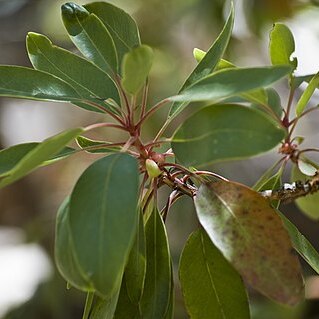Trees, 3-8[-10] m; bark light gray to reddish gray, checkered with squarish to rectangular segments or plates, 1-4 × 1-2.5 cm, retained on bole and major limbs; twigs 3+ years old with brick-red outer bark exfoliating in flakes or, sometimes, in slender strips. Leaves larger on sterile shoots with longer internodes; petiole (often red), (1-)1.7-3.2(-4.2) cm, base slightly decurrent, glabrous; blade slightly lighter green abaxially, olive-green and glossy adaxially, ovate, (2.5-) 3-7.5(-9) × (1-)1.8-3(-4) cm, base usually tapered-acute, rarely slightly rounded [broader and more nearly ovate-lanceolate], apex usually acute, sometimes slightly acuminate, surfaces glabrous. Inflorescences often congested; axes densely hairy, hairs sometimes glandular. Pedicels accrescent, obliquely erect or slightly pendulous, 2.4-5 mm (to 16 mm in fruit), densely hairy, hairs sometimes glandular; bract clasping base, reddish, scalelike, 1.4-2 mm. Flowers: calyx pale green, lobes 1.1-1.5 mm (mostly hidden beneath corolla), apex obtuse or rounded; corolla 5-5.6 mm; anthers 1.3-1.5 mm, spurs 1/2-2/3 times length of thecae, (finely tuberculate); ovary with (2-)3-5+ ovules per locule. Berries blackish red, 6.5-9 mm diam. Seeds ca. 2 mm.
More
A small tree. It keeps its leaves throughout the year. On young trees the bark is thin, smooth and dark red. It peels in long stripes. Older trees has thicker bark with long cracks. The leaves are thin and slender. They are sword shaped and pointed at the tip. The flowers are in loose clusters. The fruit are small and like strawberries. The ripen to dark orange-red. They are sweet and edible.
Dry gravelly benches, 1,800-2,400 metres. Riverine forests and oak parklands along seasonally moist waterways in foothills and lower mountains; 1,500-2,400 metres.
More
It is a temperate plant. It grows in dry gravel areas. It grows up to 2,500 m altitude in mountains in Arizona in the USA.
Can be grown by cuttings or seedlings. Seeds needs soaking and stratification.


